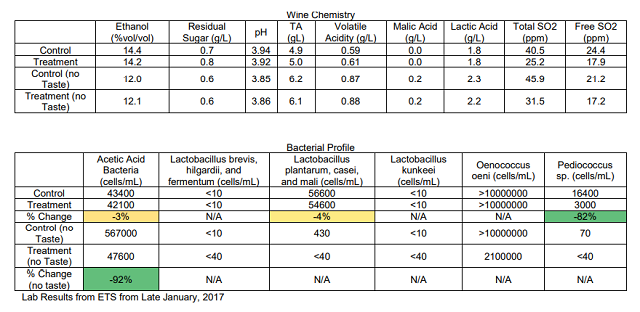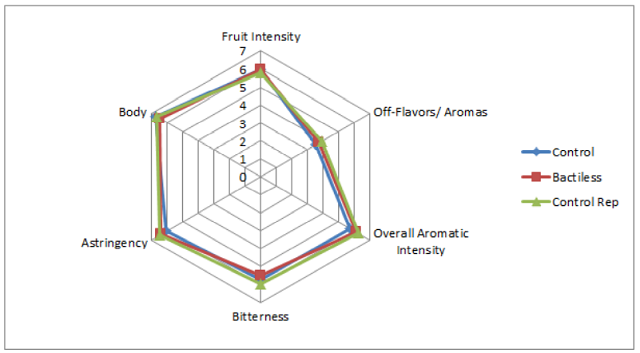The Effect of Bactiless on Microbial Stability in Petit Verdot (2016)
Matthieu Finot
King Family Vineyards
Summary
This study examines the impact of Bactiless (ScottLabs) on the chemical, microbial, and sensory profiles of two Petit Verdot wines, one of which was not tasted. Petit Verdot wine was racked into two separate barrels for each wine, and allowed to undergo natural malolactic conversion. After malolactic conversion, one barrel from each wine received a sulfur dioxide addition of 6.6g/hL, whereas the other barrel from each wine received 4.4g/hL sulfur dioxide and 50g/hL Bactiless. After 10 days both barrels were racked and returned. Bactiless seemed to lower cell counts for Pediococcus sp, acetic acid bacteria, and Oenococcus oeni. The results varied between wines, however. Other microbes were not strongly impacted by the treatment, but in many cases the cell count may have been too low to be impacted by the treatment. The wines were not significantly different from triangle testing. No major descriptive trends could be seen in this study.
Introduction
Bactiless (ScottLabs) is a chitin-glucan derived from Aspergillus niger which acts as a fining agent to remove microbes from wine. It lowers the population of both gram-negative and gram-positive bacteria in wine, while minimally impacting yeast populations. It can thus help stabilize wines or reduce bacterial load in wines (Scott Laboratories 2017). This study examines the impact of Bactiless on the chemical, microbial, and sensory profiles of two Petit Verdot wines, one of which was not tasted
Results and Discussion
Bactiless seemed to lower cell counts for Pediococcus sp, acetic acid bacteria, and Oenococcus oeni. The results varied between wines, however. Other microbes were not strongly impacted by the treatment, but in many cases the cell count may have been too low to be impacted by the treatment.


For the triangle test, of 31 people who answered, 8 people chose the correct wine (26%), suggesting that the wines were not significantly different. In general, people who answered correctly preferred the Bactiless treatment to the control (although this was a weak preference). No major trends could be found with the descriptors used in this study.


Methods
Two different batches of Petit Verdot were fermented and racked into 2 sets of 2 identical barrels. Wine was not inoculated for malolactic conversion. After malolactic conversion completed for both sets of wine, one wine from each set was stabilized with a “normal” sulfur dioxide addition of 6.6g/hL, and another wine from each set had 4.4g/hL sulfur dioxide and an addition of Bactiless at 50g/hL. After 10 days all wines were racked and returned. Only one set of the two were tasted at sensory sessions.
The wines were tasted on March 15. For the triangle test and preference analysis, anybody who did not answer the form were removed from consideration for both triangle, degree of difference, and preference. Additionally, anybody who answered the triangle test incorrectly were removed from consideration for degree of difference and preference. Additionally, any data points for preference which did not make sense (such as a person ranking a wine and its replicate at most and least preferred, when they correctly guessed the odd wine) were removed.
In order to balance the data set to perform statistical analysis for descriptive analysis, any judge who had not fully completed the descriptive analysis ratings were removed. In order to then make the amount of judges between groups equivalent, one judge from group 3 was transferred to group 2, and another judge from group 1 was eliminated. This resulted in a final data set of 3 groups, each with 9 judges (considered as replications within groups, and groups were considered as assessors). Data was analyzed using Panel Check V1.4.2. Because this is not a truly statistical set-up, any results which are found to be statistically significant (p<0.05) will be denoted as a “strong trend” or a “strong tendency,” as opposed to general trends or tendencies. The statistical significance here will ignore any other significant effects or interactions which may confound the results (such as a statistically significant interaction of Judge x Wine confounding a significant result from Wine alone). A three way, pseudo-mixed analysis of these interactions was not used to further verify whether the wine result was truly significant. The descriptors used in this study were Fruit Intensity, Off-Flavors/Aromas, Overall Aromatic Intensity, Bitterness, Astringency, and Body.
References
Scott Laboratories. 2017. New tool to control Acetobacter and other spoilage bacteria. http://www.scottlab.com/uploads/documents/Scott%20Laboratories%20-%20Bactiless%20press%20release_011617.pdf. Accessed 5/8/2017.
